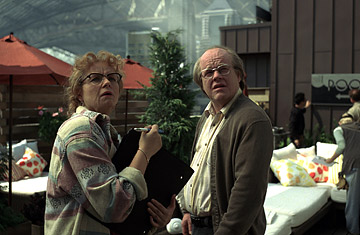
Samantha Morton and Philip Seymour Hoffman in Synecdoche, New York
Finally! For nine days, the 61st Cannes Film festival had doddered along into a premature senility. What we got, mostly, were cautious reprises of top directors, earlier pictures — from European minimalism, by Euro-faves like the Dardenne brothers and Nuri Bilge Ceylan (which, you have to admit, is a great name) — to Hollywood gigantism from the Indiana Jones team. The Riviera fortnight has been so stodgy that we almost welcomed a wild, four-and-a-half hour misfire like Steven Soderbergh's Che. But now our (my) patience has been rewarded, our (my) biliousness calmed. One good movie can do that. In 2006, Guillermo del Toro's Pan's Labyrinth showed up on the last day, to prove there was life in the old medium yet. This year the savior is Charlie Kaufman's demanding, rewarding Synecdoche, New York.
Kaufman you know as a gifted, mulish, effulgently idiosyncratic screenwriter — one of the few non-directors to establish a unique film voice — of Being John Malkovich, Human Nature, Confessions of a Dangerous Mind, Adaptation and Eternal Sunshine of the Spotless Mind. Most film scribes making their move to the director's chair would pick a modest project, one that doesn't tax his tyro status. But Kaufman's first work as a total auteur is his most daunting project yet: a portrait of a creative mind in artistic and emotional crisis, painted as a vast mural that encompasses 30-plus years, slips from mundane reality into nightmare fantasy, and is set (not counting side trips to Germany) in two New York State river cities 150 miles apart.
The first is Schenectady, the working-class city near Albany where Caden Cotard (Philip Seymour Hoffman), a theater director, lives with his artist wife Adele (Catherine Keener) and their young daughter Olive (Amy Goldstein). Caden, who's had a critical success staging Death of a Salesman with young actors in the middle-age roles, is himself a premature alter kocker: he hears mortality gargling at him everywhere. In the first scene, he wakes to a radio talk-show report about how the coming of autumn is a harbinger of death; from then on, Caden's life is one long fall. Reading the newspaper, Caden sees a headline about a playwright. "Harold Pinter's dead," he muses aloud. "No, wait, he won the Nobel Prize." He glances at the TV and sees his own animated form as part of a cartoon show, accompanied by the sing-song lyrics: "Then he died /Maybe someone cried /But not his ex-bride."
His ex-bride, Adele, is about to be his ex-wife. Invited to Berlin to mount an exhibition of her paintings, she tells Caden she'd prefer that he stay home; she'll take Olive with her. Soon, it's clear, mother and child are gone for good. That leaves Caden open to the adoring advances of Hazel (Samantha Morton), who runs the box office at his theater. Her attentions hardly distract Caden from his obsessive suspicions of a physical breakdown: a bathroom accident has left him with a scar on his forehead and the skin disease known as sycosis. Before long, even sympathetic viewers will wonder if Caden is suffering from psychosis.
